 Visorless Caps of the Soviet Navy
Visorless Caps of the Soviet NavyIntroduction
As previously stated, I broke this section out of the general Navy page in order to facilitate image downloads and to differentiate this unique type of cap from its visored relatives. Known as a "beskozirka," or more accurately as a "furazhka-beskozirka," it literally translates as "cap without a visor." It was the standard everyday-parade cap worn by Soviet sailors below the rank of Petty-Officer 2nd class and by cadets at Naval schools. This style headgear has a long history in European navies and was worn in the Russian Navy since the early 1800's. It was immediately adopted by the Red Navy following the revolution and remains in service to the current day. For most of its history it was manufactured with white piping, although that was eliminated for a time in the early 1920's (variously reported as 1921 or 1923) until restored in 1939. The rather "crumpled" shape of the all-black beskozirka of the 1920s and early 1930s was also sharpened up by restoring a spring-steel band along the inside of the crown in the late 1930s.
As with Naval officer's visor caps, the beskozirka came in two versions - black for winter wear and in white (a removable cover worn over the crown of the black cap or over a padded cap form expressly made for the white cover) for summer or tropical wear. Other than missing the visor, the beskozirka was structurally identical in all respects to the visored officer cap. It differed visibly only in the emblem worn and the use of an embossed ribbed-ribbon "tally" instead of the plain ribbon worn on visor caps. This tally at first identified the ship to which the sailor was assigned, but for all of its post-WWII history identified only the fleet or flotilla in which the seaman served (with one or two exceptions - such as those assigned to the museum warship "Aurora"). Sailors not assigned to a fleet or flotilla wore a tally embossed in gilt lettering with ВОЕННО-МОРСКОЙ ФЛОТ (Military Sea Fleet - or Navy). Naval cadets wore tallies with the name of their school. You can see examples of these different tallies below. A thumbnail image accompanies each cap description. Clicking on that thumbnail will bring up a larger, higher resolution image.
Seaman/Naval Cadet
Winter Service/Parade
1939-1968
The three caps shown here date before 1969 - as evidenced by their use of a plain star cockade, the smaller crown circumference and use of napped wool fabric vice the later blended wool. The one dated 1965 on the far left has the tally of the Soviet Navy (often indicating assignment to a naval shore-based unit) while the other two are marked: КРАСНЗНАМЕН. БАЛТ. ФЛОТ (Red Banner Baltic Fleet). The orange and black striped tally indicates the wearer of that 1967-stamped cap belonged to a Guards unit of that fleet, while the plain black band tally of the 1956-stamped cap indicates service with a non-guards element of that fleet. The piping on that same cap (far right) is wider than the others, which is a manufacturing variant often found on Navy caps. The star on these earlier caps was of a unique size - 30mm - smaller than those worn on visor caps and larger than those worn on pilotkas, and was only authorized for the beskozirka. Two of these are earlier M1947 hot enamel one-piece stars while the guards cap has the M1963 anodized aluminum star with cold enamel (paint). Scarce
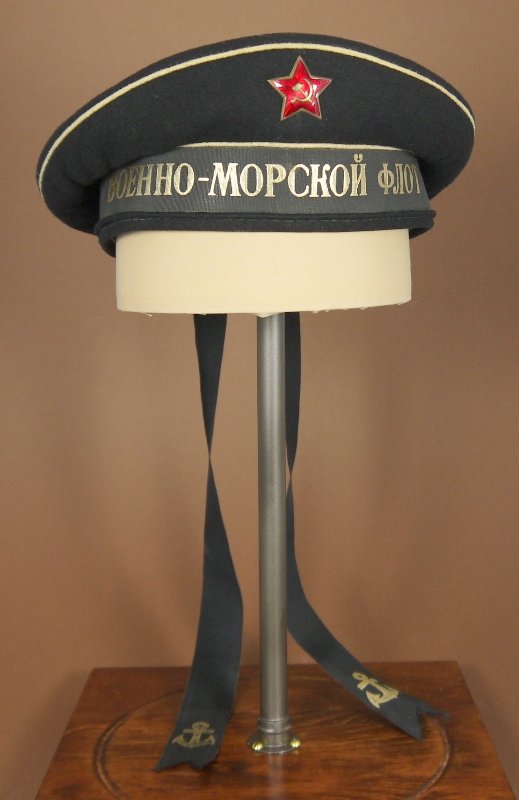
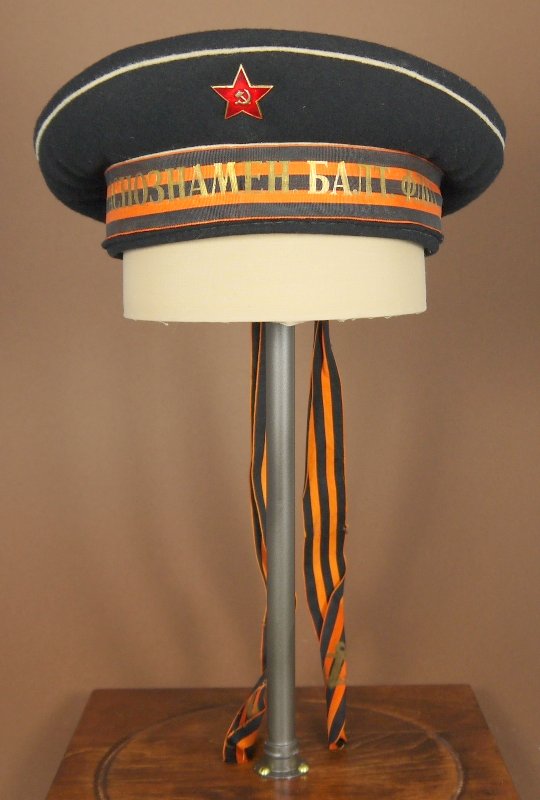
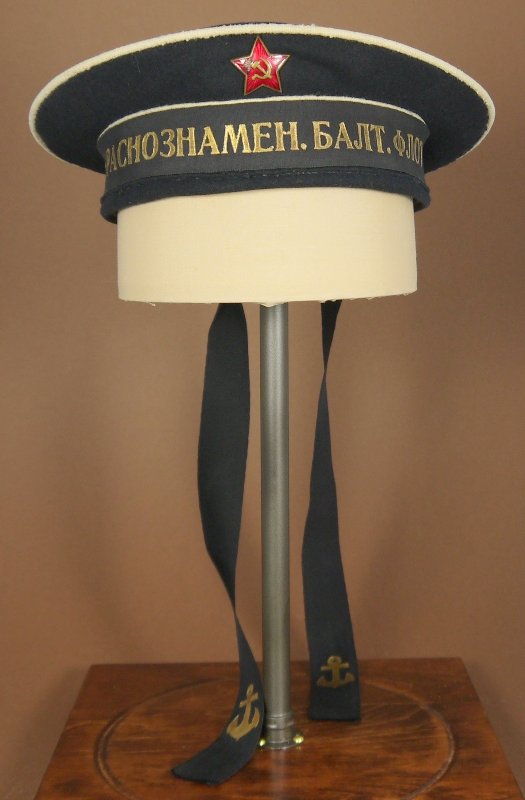
|
|
Sailors assigned to ships or units designated as "Guards" due to exemplary wartime deeds swapped out their black tallies with orange and black striped ones - colors associated with the St. George military order of Imperial Russia.
This marked the wearer as a member of an elite unit just as wear of the Guards badge marked Army and Air Force personnel. There have been a couple dozen variants of guards' tallies, capturing every fleet and flotilla as well as the Navy itself
and a small number of specialized units. Shown here is a page from the Russian uniform magazine "Old Arsenal" No.2/2001 illustrating some of these tallies.
While present in the Imperial Russian Navy, guards units (and their tallies) did not appear in the Red Navy until 1942. At the time of the collapse of the USSR, the Soviet Navy reportedly had 25 guards units (not counting Naval Infantry) in all four named fleets and under direct Navy subordination. |
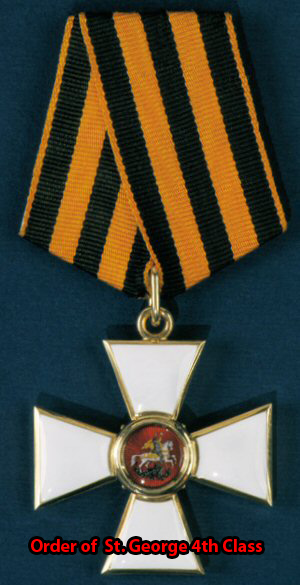
| 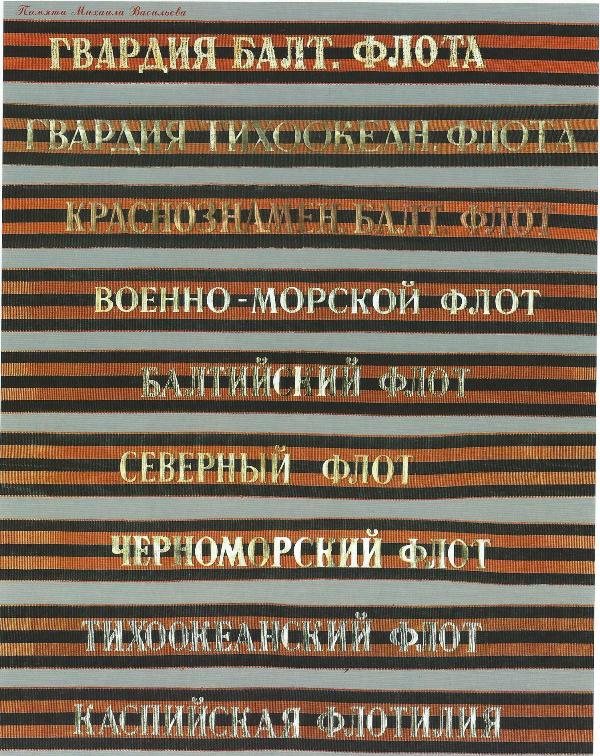
|
Seaman/Naval Cadet
Winter Service/Parade
1969-1991
This set of beskozirka represent those made after 1968. As a group, these black caps differ from earlier models in being made of blended wool fabric, having a higher and larger circumference crown, and mounting the M69 aluminum enlisted parade emblem with a red-painted star and wreath. This is the same emblem worn by conscripts in the Army and Air Force on their parade visor caps.
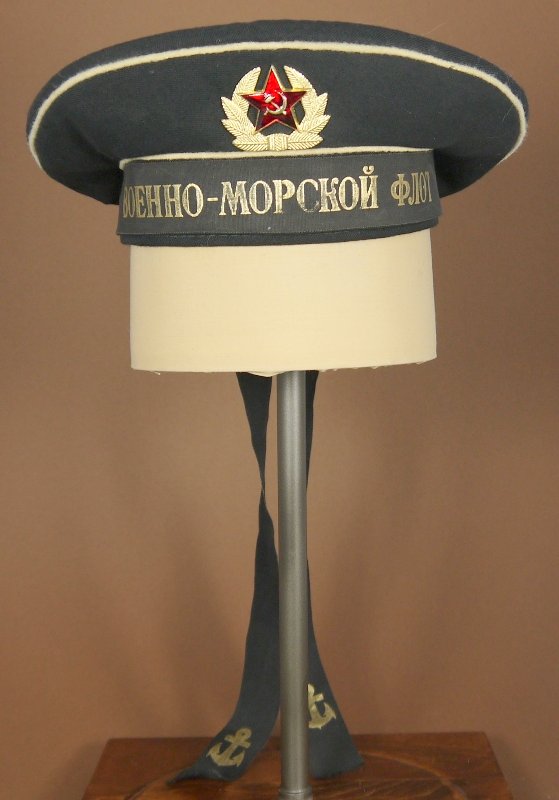
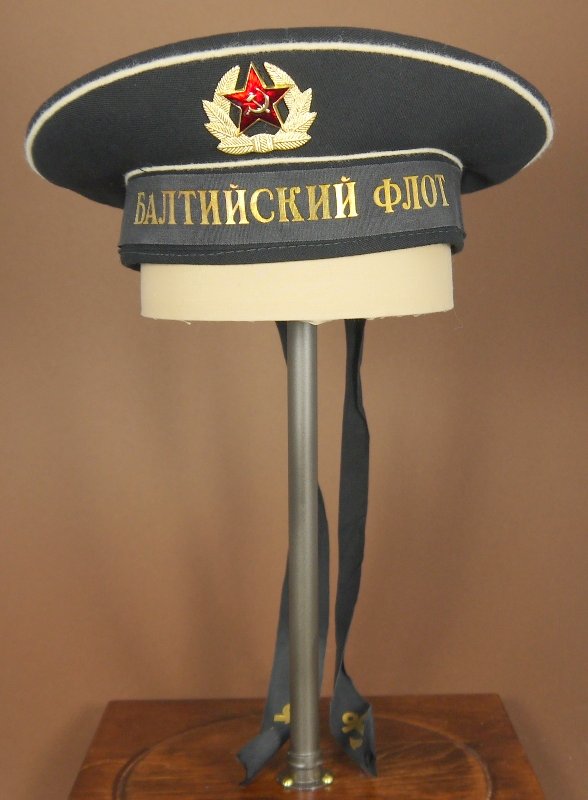
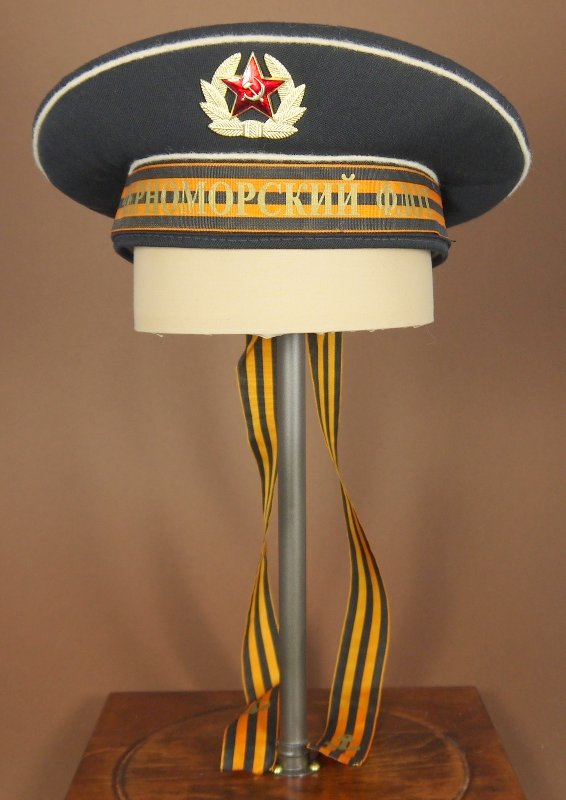
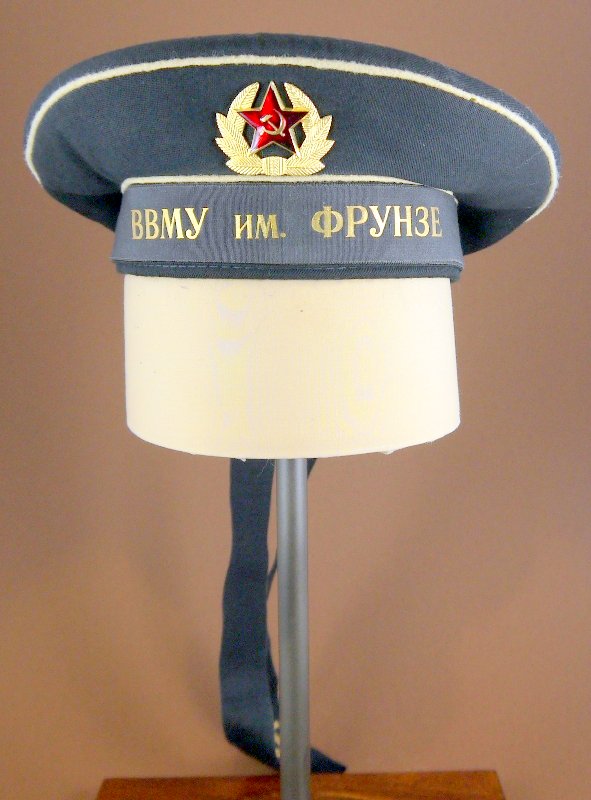
|
The first two caps are from non-Guards' units - one marked ВОЕННО-МОРСКОЙ ФЛОТ was manufactured in 1969 (one of the first of the new models) while the second, dated 1986, has a tally
for the БАЛТИЙСКИЙ ФЛОТ (Baltic Fleet). The Guards' cap is stamped in gilt paint with the name ЧЕРНОМОРСКИЙ ФЛОТ (Black Sea Fleet). While the Guards tally is hard to find, these three unit designations
are probably the most common. The last cap on the far right is for a cadet at Leningrad's ВВМУ им. ФРУНЗЕ (Higher Navy School named after Frunze), perhaps the most famous of 11 Soviet naval commissioning academies (equivalent to the US Navy's Annapolis Academy).
Each of these schools had its own unique cap tally.
Available
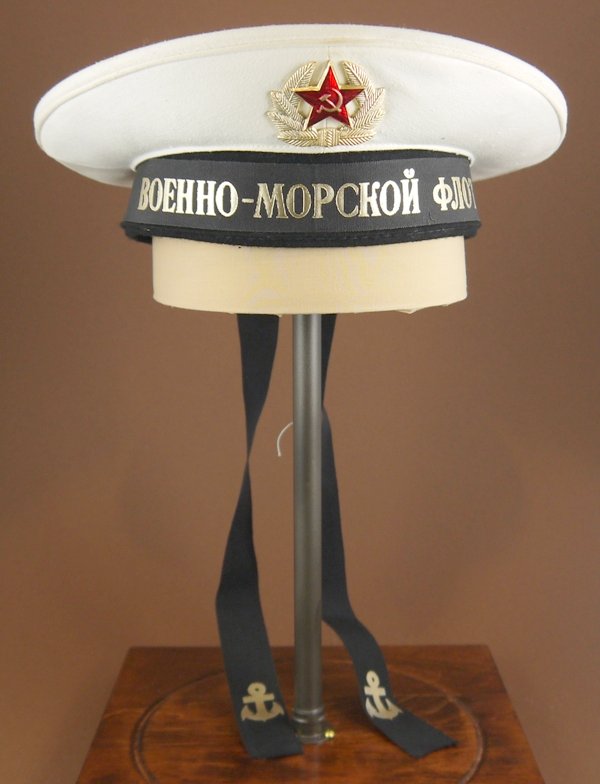
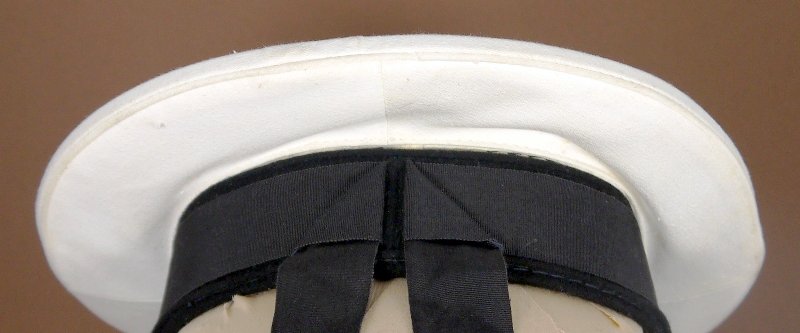 Seaman/Naval Cadet
Seaman/Naval Cadet
Summer Service/Parade
1969-1991
This 1989-dated cap is an example of a summer or tropical service beskozirka with its white cover. As mentioned previously, this cover can be found worn directly over a standard black winter cap (usually on older models) or - as here - on a special lightweight frame. A M69 star-and-wreath emblem is pinned through the cover and the tally is the more common one for the general Soviet Navy. The tally is sewn to the back of the cap in the unique, traditional configuration shown here to the right; the rest of the tally was "free-floating" sandwiched by the crown and a raised rib along the band bottom.
In order to fully appreciate the manufacture and wear of the white beskozirka, I've removed the cover from the cap's framework. As you can see in the pictures below, this frame has a normal band but the crown was just padding held loosely together by a linen covering. This lighter, less-tightly woven structure resulted in a much cooler cap than if a winter cap was worn under a white cover. Two additional white covers were normally issued with the cap to facilitate cleaning. Please note that the tops of white officer visor caps were manufactured and covered the same way as shown here. Available
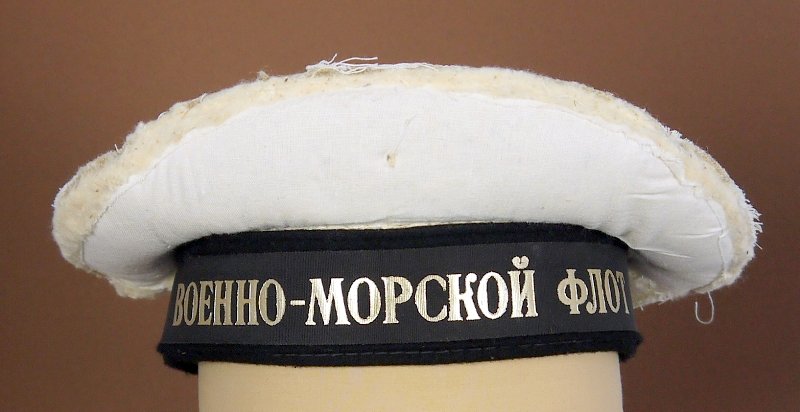
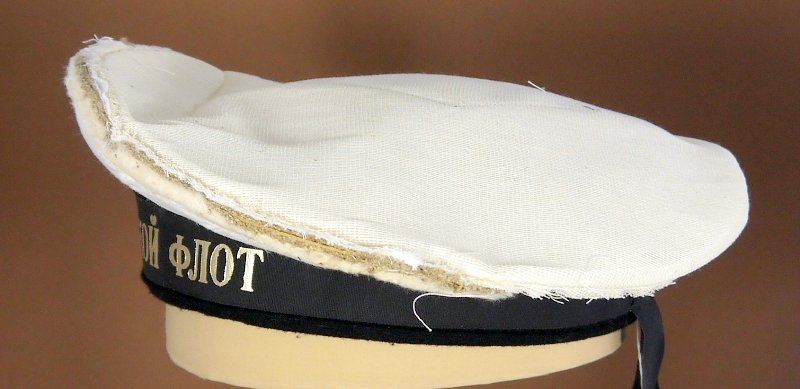
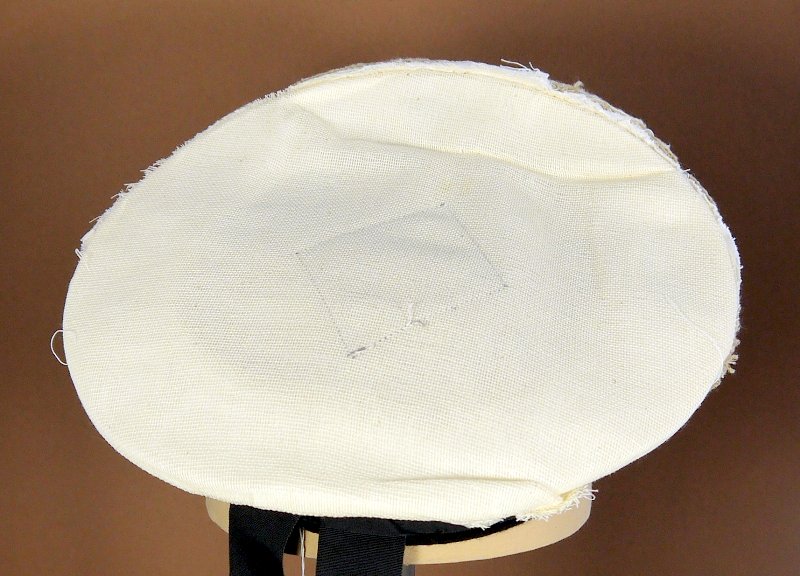
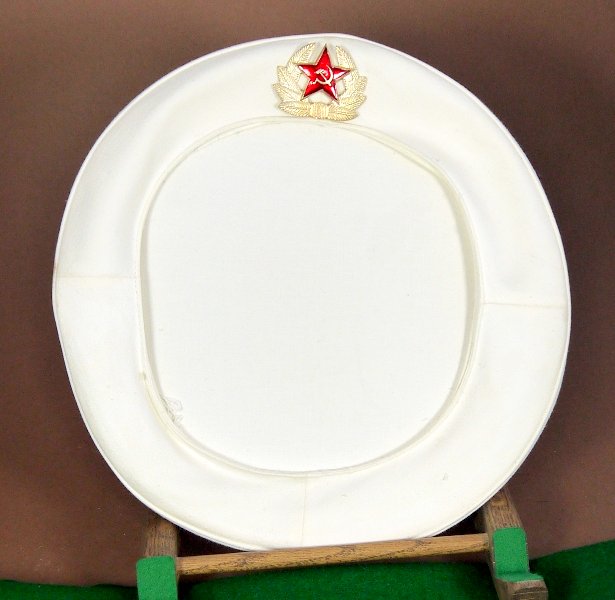
|
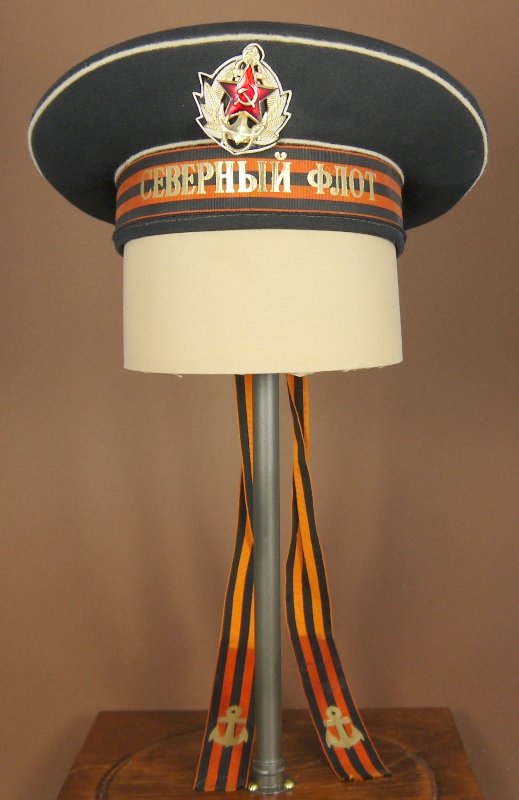
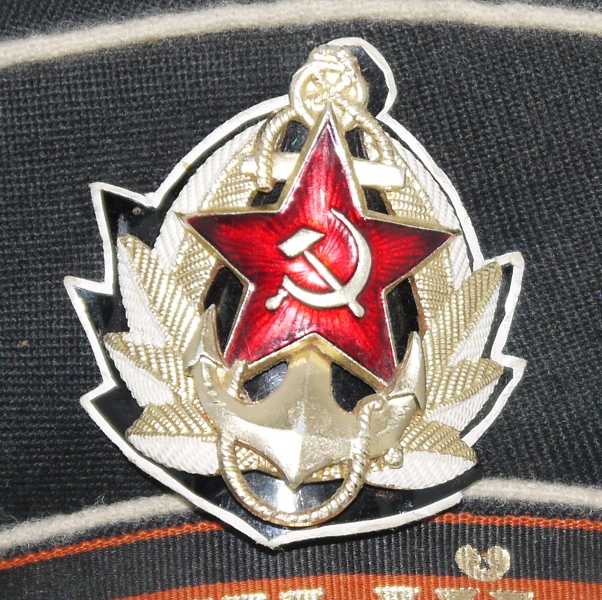 Seaman
Seaman
"Dembel - demob"
1969-1991
A final unofficial variant of beskozirka is the "demobilization" (or "de-mob"); known in Russian as "dembel." Being unofficial, you will see multiple variations of this theme - all designed to enhance the wearer's sartorial beauty and individuality upon his impending release from Naval service.
This practice of conscript soldiers/sailors modifying their uniforms to celebrate the occasion of their return to civilian life was a common one in the Soviet military, although never officially permitted. Conscripts would spend much of their free time in their final months of service incorporating elements of officer or locally fabricated insignia into their uniforms in order to look the grandest possible and impress friends and relatives back home. Officers usually tolerated these non-regulation additions as long as they were only worn during the conscripts' trip home.
In this case, since the guards ribbon of the Northern Fleet was already pretty impressive, all modifications were done to the wreathed red star cockade. First, an anchor insignia off a naval shoulder guard was cut in half and glued to the back of the standard red star cockade. The outer edge of the gilt wreath was painted white for contrast and a black and white plastic backing was cut out and attached behind it. The overall effect is somewhat crude up close, but looks quite impressive from a distance.
Interestingly enough, the back of the guards' ribbon was not sewn, but instead was held in place by wire threaded through the band at the back; once again demonstrating the wide range of modifications you can expect
when collecting Soviet uniforms.
Scarce
|
Common Beskozirka Cap Tallies and their translations :
ВОЕННО-МОРСКОЙ ФЛОТ (Navy) And, while not actual Navy - the often confused: МОРЧАСТИ ПОГРАНВОЙСК (Naval Border Guards) |